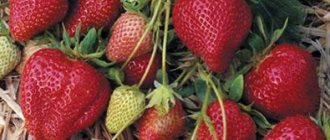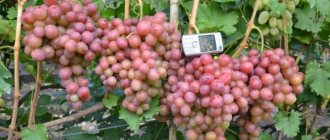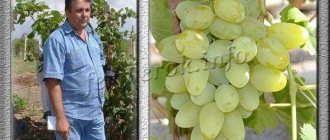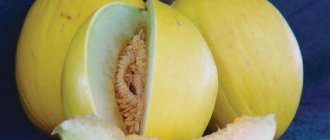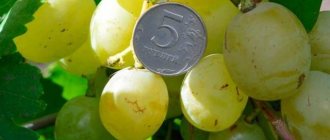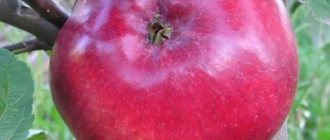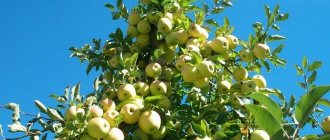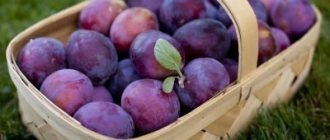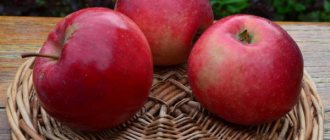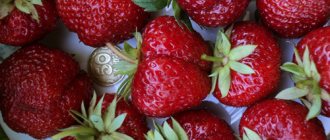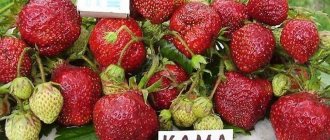- 5.1 Preparing for winter
Strawberry Tristan is a Dutch variety that is not yet widespread in Russia. Mostly, summer residents grow it in the Central region - from the North-West to the south. It is characterized by moderate winter hardiness and long-term fruiting, which lasts until the first frost. The berries are moderately large and have a distinct sweet taste.
Strawberry Tristan - variety description
“Chamora Turusi” is a late-ripening, high-yielding variety. The bushes are viable, large, fast-growing, with large dark green leaves and strong tendrils. The big advantage is long-term fruiting. The bushes produce a good harvest for 10-12 years, and can grow in one place for 5-6 years without requiring movement.
In the first year, young plants form a single peduncle, on which a large berry of a conical or slightly rounded shape is tied. Its weight can reach 150 g. After a couple of years, the number of ovaries increases significantly, but the berries become smaller - with good care, their weight reaches 100 g, but specimens weighing 50-80 g are more common. Experienced gardeners note that even without careful care, strawberries of this variety It turns out larger than most popular varieties.
“Chamoru Turusi” is valued for its high taste qualities. The berries are juicy, moderately dense, with a pleasant sweet and sour taste and rich aroma of wild strawberries. As they ripen, they acquire a bright reddish-burgundy hue. The core is white with a vein; there may be small voids near the sepals. Dense and elegant berries are ideal for sale; they tolerate transportation and storage well. In the middle zone, the main harvest ripens after July 24, but much depends on weather conditions.
Characteristics of the berry
The fruits have an elongated conical shape. Their size depends on various factors. The average weight of the berries is 28-30 g. Their calorie content is 36.9 kcal per 100 g. They have juicy pulp, a pleasant aroma and dietary taste. The berries are bright red.
Important. Can be used to treat colds and eliminate bad breath.
The berries have antimicrobial and anti-inflammatory properties. They contain carbohydrates. They practically do not increase carbohydrates in the blood, so berries are allowed to be included in the diet of patients with diabetes.
The weight and ripening of berries depends on:
- proper plant care and feeding;
- climatic conditions;
- fruiting period.
Strawberries contain iodine. The salicylic acid it contains plays an important role in joint health.
Description of the variety
This hybrid variety is classified as decorative because it has a luxurious appearance during the flowering period, all thanks to its fragrant large pink flowers. Not many varieties can “boast” of such unusual flowering. But not only for the sake of its spectacular appearance, the strawberry variety Tristan f1 is grown. It is also quite tasty and has a delicate delicate aroma.
Tristan f1 is rightfully considered one of the highest-yielding varieties. The plant is quite compact in size. Strawberries have an elongated, pointed shape and a rich red color. The taste of the fruit is delicate, sweet, sugary. During the flowering period, the plant becomes a real decoration of the site: it blooms with luxurious, large pink flowers.
The strawberry variety Tristan f1 is quite unusual, since it is one of the few varieties of strawberries that do not throw out shoots when propagated. That is, this plant is practically beardless. Farmers call such strawberries alpine remontant strawberries.
Strawberry seeds Tristan
It is worth noting that in terms of its characteristics, this variety differs for the better from its “mustachioed” relatives:
- incredibly long (almost throughout the entire summer period until the onset of autumn) fruiting;
- In terms of their taste, strawberries can easily replace strawberries;
- large-fruited variety;
- incredibly rich and stable harvest (you can get hundreds of fruits from one bush);
- the inability to form new shoots undoubtedly simplifies the process of caring for the plant in the beds.
Advice. Since the Tristan f1 variety practically does not form tendrils during the period of active growth, the plant can be planted quite densely on the site. You can add a “neighbor” to the beds - strawberries of the Laurent f1 variety.
Gardeners speak of this variety as quite unpretentious, actively and beautifully flowering and producing an excellent harvest of delicious, albeit not very large, fruits.
Description of berries
Scarlet glossy berries of "Tristan" are not only beautiful, but also very tasty. The fruits have an elegant elongated conical shape and have a delicate, juicy pulp that is superior in sweetness and aroma to ripe wild strawberries.
The berries of this decorative hybrid are not large, but taking into account the fact that each Tristan bush produces more than a hundred of these strawberries per season, this variety can certainly be classified as particularly productive.
Attention! Due to the fact that the flower stalks of “Tristan” are prone to lodging, the ground under the bushes of this variety must be mulched with lutrasil or spunbond.
Strawberries "Tristan" bear fruit almost all summer
Strawberry Tristan - variety description
Any experienced amateur gardener knows well that strawberries in the garden most often reproduce through growing young shoots, from which new seedlings are subsequently formed. But there are certain types of strawberry plants that are bred only through seedlings, which is why none of their agrotechnical parameters suffer. Moreover, they have a certain advantage over conventional varieties, manifested in accelerated development and reduction in the time it takes for berries to appear.
We will talk about such an unusual representative of garden berry crops as the Tristan f1 strawberry. This variety should be classified as a hybrid variety of garden plants, which are most often classified as ornamental. Their rosettes stand out noticeably against the general background of strawberry bushes due to their bright pink inflorescences and are often used for decorative design of garden areas and plots.
They often plant garden beds with flowers, and also decorate summer terraces and small balconies in dachas. But this berry attracts gardeners not only for its decorative properties. Based on the numerous reviews of people involved in growing Tristan strawberries, we have to admit that its berries taste very sweet and have a rather subtle strawberry aroma.
Description and specific features of the variety
"Tristan" bushes are densely leafy, lush, but compact. The average height of the rosettes is 25 cm.
“Tristan” is a remontant late-ripening hybrid, so flowering and fruiting of plants of this variety continues from mid-June until the beginning of the first autumn frosts.
Rosettes of "Tristana" become especially beautiful during the period of mass bud blooming, but even after the first wave of flowering subsides, the bushes strewn with ripening berries look very elegant. The flowers of this hybrid are truly magnificent - large, deep pink and very fragrant.
Another advantage of this variety is its high disease resistance. "Tristan" has genetically fixed resistance to most viruses and fungi that infect berry crops of the Rosaceae family.
Advice. Due to the fact that the Tristan bushes do not form tendrils, the seedlings of this hybrid can be planted more densely than the rosettes of other traditional strawberry varieties.
During the growing season, the bushes of most varieties of strawberries actively form lateral shoots, which quickly take root and thereby provide gardeners with material for further propagation. “Tristan” is a very unusual variety in this regard - unlike its relatives, it does not throw out mustaches, and therefore It can only be propagated by sowing seeds for seedlings.
Ampelous strawberries with pink flowers: care and cultivation, photo
Includes a set of activities. Among the main works:
Removing weeds and dry leaves from the beds. Work is carried out as needed throughout the growing season.
Loosening the soil
It is especially important to do this after heavy watering and rain.
Hilling. Work is carried out as needed, but at least once a month.
Top dressing
For each stage of growth, a different fertilizer is used.
Mulching the soil. Filling the rows with mulch significantly reduces the number of weeds.
The main feeding of strawberries is done in early spring. Complex mineral fertilizers are applied to the soil. They contain nitroammophoska. It is diluted with water at the rate of 1 tablespoon of the substance per 10 liters of water. During this period, mullein or bird droppings diluted with water in a ratio of 1:10 are used as organic fertilizer. Dissolve 0.5 liters at the root.
At the stage of bud formation and berry set. To increase productivity, bushes are sprayed with boric acid at the rate of 1/2 teaspoon per 10 liters of water. Potassium nitrate, wood ash or an infusion of bird droppings are added to the soil.
At the stage of preparation for winter. Nitroammophoska diluted in 10 liters of water is added to the soil in the amount of 2-2.5 tablespoons or 1 glass of wood ash.
To dilute fertilizers, only warm water is used. To increase productivity, excess whiskers are removed. After 3-4 years of cultivation, the beds are moved to a new location.
Reproduction
It is advisable to cover the container with the sprouts that have not yet hatched with plastic immediately after planting them.
At the moment when the first sprouts with barely visible leaves appear from the ground, they will need to be carefully transplanted into separate pots (dive). This usually happens about a month after sowing the seeds. The readiness of seedlings for planting in open (unprotected) ground is determined by the appearance of 5 true leaves, observed approximately a month after the completion of picking.
In addition, decorative strawberries are additionally fed with folk remedies made from a pinch of vitriol dissolved in a bucket of warm water, as well as a few drops of iodine and potassium permanganate. This homemade mixture in liquid form is applied directly under the growing bushes.
This variety of strawberry is grown exclusively for seedlings. Sowing seeds can begin at the end of February, preferably in early March. The pre-prepared soil substrate should be slightly moistened (the soil should not become heavy), after which sowing can be carried out. There is no need to sprinkle the seeds with soil. The container with sowing must be covered with polyethylene or a lid.
As soon as the first two leaves appear from under the ground, the young shoots can be carefully planted into separate pots. This usually happens approximately a month after sowing the seeds.
The plant is planted in open ground when at least 5 full leaves appear on the seedlings - approximately a month after picking. When planting seedlings, keep the distance between individual plants at least 15 cm, the distance between rows should be about 30 cm.
Tristan berry
Advice. In addition to mineral fertilizers, homemade “tasty” fertilizer is perfect for decorative strawberries. To prepare it, you will need a few drops of iodine, potassium permanganate, and a pinch of copper sulfate. All this must be dissolved in a bucket of water. Fertilizer can be applied by watering the plant directly.
This concludes our acquaintance with the decorative hybrid variety Tristan. If you decide to grow it in your garden plot, try to put a piece of your soul into the process and the result will certainly impress you. Good luck!
Top dressing
The main feeding of strawberry varieties is carried out with the arrival of spring. Specially designed mineral fertilizer complexes are added to the soil. The main component of such drugs is nitroammophoska. To do this, you need to take 1 tablespoon of the substance and dilute it in 10 liters. water. Organics are also used at this point. Most often, mullein or bird droppings are used. These substances are also diluted with water in a ratio of 1:10. After preparing the solution, add 500 g of it to each strawberry bush.
During the formation of buds on the bushes, as well as during the period of berry ovary, in order to increase productivity, the plants are sprayed with a solution of boric acid 1/2 tsp per 10 liters. water. In addition, potassium nitrate, wood ash or bird droppings are added to the soil.
To prepare the solution, you must use only warm water. To increase the yield level several times, remove excess tendrils from the bushes. After 3-4 years of growth, the place for growing strawberries needs to be changed.
Winter care
Preparing for winter at home can be done in several ways:
- move the plant to the garden bed and insulate it with fallen leaves;
- insulate the plant in the flowerpot with straw mats;
- move the pot with the plant to the cellar.
Depending on the chosen variety and planting method, the plant requires different care. In one case, you need to trim off excess inflorescences and tendrils, in the other, on the contrary, to promote their formation. The main thing in growing a hanging plant is proper watering and fertilizing. They must be completed efficiently and on time. Otherwise, the plant will wither and die.
Advantages and disadvantages
The main advantages of this decorative variety include:
- A very long fruiting period, lasting almost the entire summer, until the onset of autumn cold weather.
- Excellent taste of the berries, in no way inferior to strawberries.
- Relatively large sizes of strawberry fruits and, as a result, a rich harvest.
- Caring for the plant is quite simple and does not require the removal of new shoots.
Most amateur gardeners speak enthusiastically about the Tristan variety as an unpretentious ornamental plant that has virtually no drawbacks and produces a good harvest, albeit not large, but very tasty berries.
In the final part of the review, we note that growing this variety in dacha conditions is not a difficult task at all, one might say pleasant. When breeding Tristan, in addition to obtaining a sweet and aromatic berry, it can be used to decorate the veranda or balcony of a residential house.
For several years she worked as a television program editor with leading producers of ornamental plants in Ukraine. At the dacha, of all types of agricultural work, she prefers harvesting, but for this she is ready to regularly weed, pull, shed, water, tie, thin out, etc. I am convinced that the most delicious vegetables and fruits are those grown with your own hands!
Found a mistake? Select the text with the mouse and click:
You need to collect medicinal flowers and inflorescences at the very beginning of the flowering period, when the content of nutrients in them is highest. Flowers are supposed to be picked by hand, tearing off the rough stalks. Dry the collected flowers and herbs, scattered in a thin layer, in a cool room at natural temperature without access to direct sunlight.
Humus is rotted manure or bird droppings. It is prepared like this: the manure is piled up in a heap or pile, layered with sawdust, peat and garden soil. The pile is covered with film to stabilize temperature and humidity (this is necessary to increase the activity of microorganisms). The fertilizer “ripens” within 2-5 years, depending on external conditions and the composition of the feedstock. The output is a loose, homogeneous mass with a pleasant smell of fresh earth.
The homeland of pepper is America, but the main breeding work on developing sweet varieties was carried out, in particular, by Ferenc Horvath (Hungary) in the 20s. XX century in Europe, mainly in the Balkans. Pepper came to Russia from Bulgaria, which is why it received its usual name - “Bulgarian”.
One of the most convenient methods for preparing a harvest of vegetables, fruits and berries is freezing. Some believe that freezing causes the nutritional and health benefits of plant foods to be lost. As a result of the research, scientists have found that there is practically no decrease in nutritional value when frozen.
In little Denmark, any piece of land is a very expensive pleasure. Therefore, local gardeners have adapted to growing fresh vegetables in buckets, large bags, and foam boxes filled with a special earthen mixture. Such agrotechnical methods make it possible to obtain a harvest even at home.
Tomatoes have no natural protection against late blight. If late blight attacks, any tomatoes (and potatoes too) die, no matter what is said in the description of the varieties (“variety resistant to late blight” is just a marketing ploy).
Both humus and compost are rightfully the basis of organic farming. Their presence in the soil significantly increases the yield and improves the taste of vegetables and fruits. They are very similar in properties and appearance, but they should not be confused. Humus is rotted manure or bird droppings. Compost is rotted organic remains of various origins (spoiled food from the kitchen, tops, weeds, thin twigs). Humus is considered a higher quality fertilizer; compost is more accessible.
From varietal tomatoes you can get “your own” seeds for sowing next year (if you really like the variety). But it is useless to do this with hybrids: you will get seeds, but they will carry the hereditary material not of the plant from which they were taken, but of its numerous “ancestors”.
It is believed that some vegetables and fruits (cucumbers, stem celery, all varieties of cabbage, peppers, apples) have “negative calorie content,” that is, more calories are consumed during digestion than they contain. In fact, only 10-20% of the calories received from food are consumed in the digestive process.
Description and characteristics
Tristan cherry strawberries differ from most other remontant strawberry plants in the compactness of their bushes, not exceeding 25 cm in height and 30 cm in diameter, as well as the absolute absence of tendrils. This feature of the Tristan F1 hybrid allows it to be grown in small areas and even in household containers of sufficient volume (in pots, for example).
The general characteristics of this plant can be supplemented by the following properties:
- The inflorescences of the crop appear quite early, producing a large number of large flowers with a dark pink tint.
- The first berries begin to ripen around mid-June.
- Abundant fruiting of bushes of this variety continues throughout the entire growing season, which lasts no more than 4 months, and on unprotected soil it may not stop until autumn frosts.
In appearance, Tristan strawberries (also called garden strawberries) are very smooth, relatively large and weigh about 25-30 grams. Their shape resembles a double cone, and their color is dark red, with a glimmer.
The taste of the fruits of this variety is considered to be dessert, while the hybrid itself is classified as highly productive, ensuring the collection of berries not only from the main (mother) bushes, but also simultaneously from the daughter rosettes located nearby. The additional fee is not so high, but it is guaranteed even without rooting the cuttings.
Additional Information. When planting seedlings in a garden bed, it is allowed to leave a distance of about 15-20 cm between individual sprouts, and 30-35 cm from one row to another.
Tristan strawberries, the variety description of which was discussed in this section, perfectly retain their shape under long-term storage conditions, which allows them to be transported over long distances. This property implies the possibility of their use for commercial purposes (that is, for sale).
Preparing for winter
Strawberries can overwinter without shelter only in the southern regions. To prevent plant death in temperate regions, strawberry plantings are covered with non-woven material or mulch for the winter. Suitable:
- hay;
- straw;
- pine and spruce branches;
- leaf litter
Breeders also recommend selecting winter-hardy varieties adapted to local conditions. Cover the beds just before the cold weather, otherwise the bushes will dry out. When using fabric (agrofibre), first arrange arcs over the bushes, then lay the canvas on them.
Also, before wintering, remove damaged and red leaves, tendrils, and weak shoots.
The beds are covered with snow on top of the shelters. In such conditions, strawberries will not freeze even in the harshest winters.
Continuous fruiting strawberries require complete and proper care. This is not a crop for the lazy, but for those who are ready to care for plantings of remontant strawberries and follow the rules of agricultural technology. The result is an excellent harvest of tasty and sweet berries throughout the summer season.
Natalia Severova
Seed propagation
Strawberries of the Tristar variety can be propagated by seed and with the help of tendrils. Most often, seedlings obtained from seed germination are used. They are germinated in several stages. Initially, they are placed on two slightly moistened napkins. After spraying from a spray bottle, they are placed in a plastic bag. Within a few days, the seeds increase significantly in size.
Important! Throughout this time, napkins with seeds should be periodically moistened
This is followed by other preparatory stages, namely:
Keep the seeds for two weeks at a temperature of +4 degrees. Then they germinate for 2-3 weeks at a temperature of 18 to 22 degrees. After this time, the seeds are transferred to peat soil
It is very important that the seeds have a shoot of at least 1 cm before being added to the soil. If the seeds are germinated in the autumn or winter, then additional lighting is provided for them. When planting seedlings in a container, the volume of the container should be from 2 liters
for one material. When planting Tristar strawberries in closed ground, the soil needs to be changed every two years, but the soil must first be warmed up
When planting seedlings in a container, the volume of the container should be at least 2 liters. for one material. When planting Tristar strawberries in closed ground, the soil needs to be changed every two years, but the soil must first be warmed up
If seeds are germinated in autumn or winter, then additional lighting is provided for them. When planting seedlings in a container, the volume of the container should be at least 2 liters. for one material. When planting Tristar strawberries in closed ground, the soil needs to be changed every two years, but the soil must first be warmed up.
When planting seedlings in open ground, it is initially watered with water at a temperature of 60 degrees. For irrigation, potassium permanganate is added to the water.
Landing
When planting strawberry bushes of the Tristar variety on a plot, it is necessary to maintain a distance of 60-80 cm between bushes, and at least 90 cm between rows. The planting site must be changed after two years of fruiting. Plants can be planted in open ground only when five full leaves appear on the planting material.
If Tristar strawberries grow indoors, then the year-round harvest directly depends on:
- Time of planting of planting material.
- Illumination of beds.
- Thorough watering.
- Timely feeding.
When planting bushes in open ground, they begin to prepare the soil in advance, from October. Add to the soil:
- Special organic fertilizers.
- Lime, for less acidification.
- Potassium chloride and superphosphate.
It is very good that lateral shoots do not form on the strawberry bushes of the Tristar variety. This factor greatly simplifies life for gardeners, since the plant requires less care.
Agricultural technology: what to pay attention to
Planting and care are standard, as for conventional varieties
But you need to pay attention to some features and rules of cultivation
Climbing varieties are cultivated in various ways:
- in hanging containers;
- in pots (at home);
- on equipped vertical beds (pipes);
- on racks;
- in boxes in the form of a pyramid;
- in bags.
They think through the composition of the nutrient soil and irrigation systems. It is convenient to water hanging specimens through trays, this makes it easier to avoid excess moisture. Drip irrigation systems are suitable for greenhouses and beds, where water is supplied in doses and at certain intervals.
The planting site is chosen in a slight shade, since in the sun the bushes grow worse and produce a small number of flower stalks. Feed once every 14-16 days, using complex formulations containing phosphorus, potassium, and microelements. Organic matter is suitable for growing the green mass of climbing strawberries (if the bushes grow in beds).
If the main goal is to pick berries, then no more than two tendrils with 2-3 rosettes are left on the plant. All others are cut off. The mother plant is not able to feed a larger number of flowering and fruiting shoots.
When growing garden strawberries, only dried and excess shoots are pruned as decoration. There will be few berries, but the plants will delight you with their lushness and abundant flowering. Every 2-3 years, plantings are rejuvenated by preparing seedlings in advance.
The varieties are propagated by sowing seeds and rooting rosettes from the tendrils. When it comes to F1 hybrids, seeds are not suitable for producing seedlings, so you need to buy new material every year or try to propagate the crop using rosettes. Planting frigo seedlings gives good results.
It is advisable to change the soil in pots and cache-pots every year, and after 2-3 years, replant the plants to a new location. When cultivating climbing varieties in beds with trellises (as supports), the planting location must be changed, taking into account crop rotation and plant compatibility.
Climbing strawberries, if you don’t pick on the terms, are a productive and very decorative variety of your favorite crop, grown in flowerpots, baskets, pots and beds
The varieties are suitable for those for whom it is important not only to get a harvest, but also to decorate a plot or balcony in a beautiful, unusual way
Natalia Severova
Watering
"Tristar" is a moisture-loving variety. Regular watering is necessary from early May to September. The best method is drip irrigation. Strawberries should receive sufficient moisture, but water stagnation should not be allowed. The first watering of those grown in open ground is carried out before the first shoots emerge to warm the ground.
Each type of soil must have its own moisture content:
- sandy - 65-70% during growth, 60-65% after harvesting;
- heavy soil - 80%;
- chernozem - 70-75%.
The average water consumption when irrigating light soils is 80-100 cubic meters per 1 hectare. On loams it increases to 120 cubic meters per 1 hectare. In dry spring, watering of plants begins at the end of April. In cold summers, water no more than 3 times a month.
On hot days the amount increases 2-3 times
It is especially important to strengthen on sandy soils. In autumn, high humidity poses a serious danger to strawberries.
It leads to rotting of the root system. In damp soil, pathogenic microorganisms and bacteria actively develop, leading to the death of the plant. In dry autumn, the beds are watered once a week.
Reproduction
You can propagate using seeds and tendrils. The main method of propagation is seedlings. It is grown using seeds. Their germination occurs in several stages. First, the seeds are placed between two paper napkins and sprinkled with water from a spray bottle, after which they are placed in a plastic bag. In this state, the seeds swell for 2-3 days at room temperature. Moisturizing is carried out during this period every day.
The following stages of preparation:
- Maintain for 14 days at a temperature of +4°C.
- Germination takes 2-3 weeks at a temperature of +18-22°C.
- Transferring seeds to peat soil.
Important. Seeds with shoots of at least 1 cm are transferred to the prepared soil.
When germinating seeds in autumn or winter, additional lighting is provided for them. Use fluorescent lamps. If seedlings are planted in containers, then the volume of containers is taken at the rate of 2-3 liters per 1 bush. In closed ground, bushes are replaced after 2 years of fruiting. Before planting seedlings, warm the soil. When planting seedlings in open ground, it is filled with water at a temperature not lower than +60°C. Potassium permanganate is added to water for irrigation.
Sowing seeds can be done at any time of the year. When grown in open ground, sowing is done in late January or early March. The soil for seedlings is prepared from 3 parts sand and 5 parts humus. To warm the soil at home, you can use an oven. The soil prepared for planting is placed in it for 3-4 hours and kept at a temperature of 90-100°C.
When propagated by whiskers, they are buried in the ground. After the root system has developed well, the mustaches are transplanted to the beds prepared for them.
Reproduction and cultivation
"Tristan F1", like other strawberry hybrids, is intended primarily for seed propagation.
The cost of purchased seeds is very high, so you should purchase them only from trusted manufacturers, paying attention to the presence of the “F1” marking and expiration dates. Some gardeners believe that it is more reliable to contact European suppliers who ensure good germination and rapid germination of seeds
Further production of seedlings from grown hybrids is possible using conventional vegetative methods: daughter rosettes (if available) or dividing bushes.
There are opinions that high decorativeness and productivity are inherent in plants grown from seeds or obtained with the help of mustaches, and as a result of dividing the bushes, these qualities are significantly reduced
The Tristan hybrid is easy to care for, but requires regular, abundant watering and weekly organic fertilizing. It is positioned as relatively winter-hardy and shade-tolerant, resistant to major crop diseases, including gray fruit rot.
Diseases and pests
Strawberry "Tristar" has good resistance to various diseases, but this does not exclude the possibility of being affected by them. Existing diseases can be divided into 3 large groups:
- Fungal (anthracnose; white, gray and black rot; rhizoctonia; white, brown, brown and red spots; powdery mildew; gray mold; phthitophorosis of roots, etc.)
- Bacterial (leaf scorch, root cancer, mottling and wrinkling viruses).
- Mycoplasma (greening of petals, devil's broom).
Various drugs are used to combat strawberry diseases. Many diseases are the result of improper care.
Important. To combat, you can use solutions of iodine and potassium permanganate.
Among the most dangerous strawberry pests are garden mites and spiders, aphids, wasps and birds.
Features of agricultural technology
Regardless of the variety, garden strawberry bushes take root well in about three weeks after planting in a permanent place. In the first year after planting, it is recommended to remove the flower stalks, which will allow the plant to direct all its efforts to adapt to new growing conditions.
When performing two-line planting, it is necessary to maintain a distance between the rows of 75–80 cm, and between the lines themselves of 30 cm. The distance in the rows is approximately 20–25 cm. The standard width of the ridge should not be more than one meter, which will make caring for plants more efficient. comfortable and light.
Caring for garden strawberries involves the following mandatory measures:
removal of dry leaves from berry plantings throughout the entire growing season of garden strawberries; timely and shallow loosening of the soil, which is especially important after rains or irrigation activities; hilling strawberry bushes and regular weeding of weeds in beds with berry plantings; systematic application of fertilizers, which should be optimal in composition for each stage of development of the berry crop; mulching the soil on ridges using modern non-woven covering materials or organic matter.
| Timing for feeding strawberry bushes | Fertilizers used | Peculiarities |
| Early spring period | Complex mineral fertilizers in the form of nitroammophoska with a calculation of 1 tbsp. l. per 10 liters of warm water or organic fertilizers in the form of mullein infusion/bird droppings, diluted in a ratio of 1:10 | Watering at the root, with a flow rate of 0.5 liters per berry bush |
| At the stage of budding and ripening of the berry | Potassium nitrate, wood ash or bird droppings infusion | To increase productivity, it is recommended to carry out additional spraying with boric acid at the rate of 1/2 tsp. for a bucket of water |
| Preparing for winter | Complex mineral or organic fertilizers in the form of 2–2.5 tbsp. l. nitroammophoska and 1 cup of wood ash per 10 liters of water | Combination with moisture-recharging autumn watering of berry plantings |
On beds reserved for the cultivation of pure-quality mother plants, when carrying out weeding and loosening, the tendrils should not be injured, which will allow preserving the maximum amount of high-quality planting material. On ridges allocated for growing strawberry bushes for the purpose of harvesting, complete and timely removal of the mustache is mandatory.
When growing remontant varieties of garden strawberries, some features of this berry crop should be taken into account. Fruit-forming buds on such varieties are formed when the daylight hours are 16–17 hours, which is typical for the period from the last week of May to mid-July. At the initial stage of flowering, berry plantings require daylight hours of more than 12 hours. The bulk of the harvest on remontant varieties is formed closer to the autumn period.
Features of the plant and consumer qualities of berries
“Tristan F1” differs from most remontant varieties and hybrids of garden strawberries in the compactness of the bushes (up to 25 cm in height and up to 30 cm in diameter) and the almost complete absence of tendrils, which allows it to be grown with a high planting density and in small pots.
The plants bloom early and very abundantly; the flowers are large with dark pink petals. The first berries usually ripen in early to mid-June. Intensive flowering and fruiting continue almost continuously throughout the entire growing season (about 4 months), in open ground - until autumn frosts.
Strawberries "Tristan F1", according to gardeners, have a particularly sweet taste and delicate aroma
The berries are aligned: large and medium in size (weighing up to 25-30 g), elongated conical or biconical shape, dark red in color, shiny. Their taste is called dessert with a rich sweetness, which depends little on the temperature during the ripening period. The hybrid is considered highly productive: the harvest is formed not only on the mother bushes, but also on the daughter rosettes (even without rooting), which grow, however, in very small quantities. The collected berries are well transported.
Origin and purpose
“Tristan” is one of the brightest representatives of the strawberry collection developed by breeders of the ABZ Seeds company (Netherlands), which specializes in creating new F1 hybrids. To date, the Dutch have developed more than 20 decorative varieties, distinguished by large flowers, unusual in shape and bright colors in white, pink and red tones. The beauty and productivity of these plants have earned high marks from experts and have repeatedly received prestigious awards at international exhibitions in Europe and the USA. None of the decorative strawberry hybrids are included in the State Register of Russia, nor are they officially registered in other post-Soviet countries. However, many domestic summer residents are already well acquainted with these plants and have experience in growing them.
Strawberry Tristan F1 (pictured) is very impressive with abundant flowering and fruiting, which occur simultaneously and almost continuously
Strawberry hybrids are divided into groups intended:
- for amateur cultivation as ornamental plants in the open ground, in pots and hangings, in home and greenhouse conditions. At the same time, they serve not only as decoration for landscape design or interior design, but also provide high yields of berries;
- for commercial cultivation of flowering seedlings, which are in great demand on the market, and commercial production of berries.
What are Frigo strawberries?
Translated from Italian, “frigo” means cold, so the technology for growing strawberries has to do with lower temperatures. Its main goal is the possibility of year-round cultivation of the crop, thanks to which gardeners from around the world have long appreciated the Dutch innovation.
The main thing to understand is that Frigo strawberries are not a variety, but rather a collection of very different varieties, the young plants of which are provided with all the conditions for a long dormant period, so that planting material can be used at any time. Such conditions are organized in a carefully controlled way, not without the participation of cold.
Important! With early acquisition of Frigo seedlings and further maintenance of seedlings in indoor conditions, an early onset of development is possible, after which once-flowering varieties will no longer be able to produce a full summer harvest.
